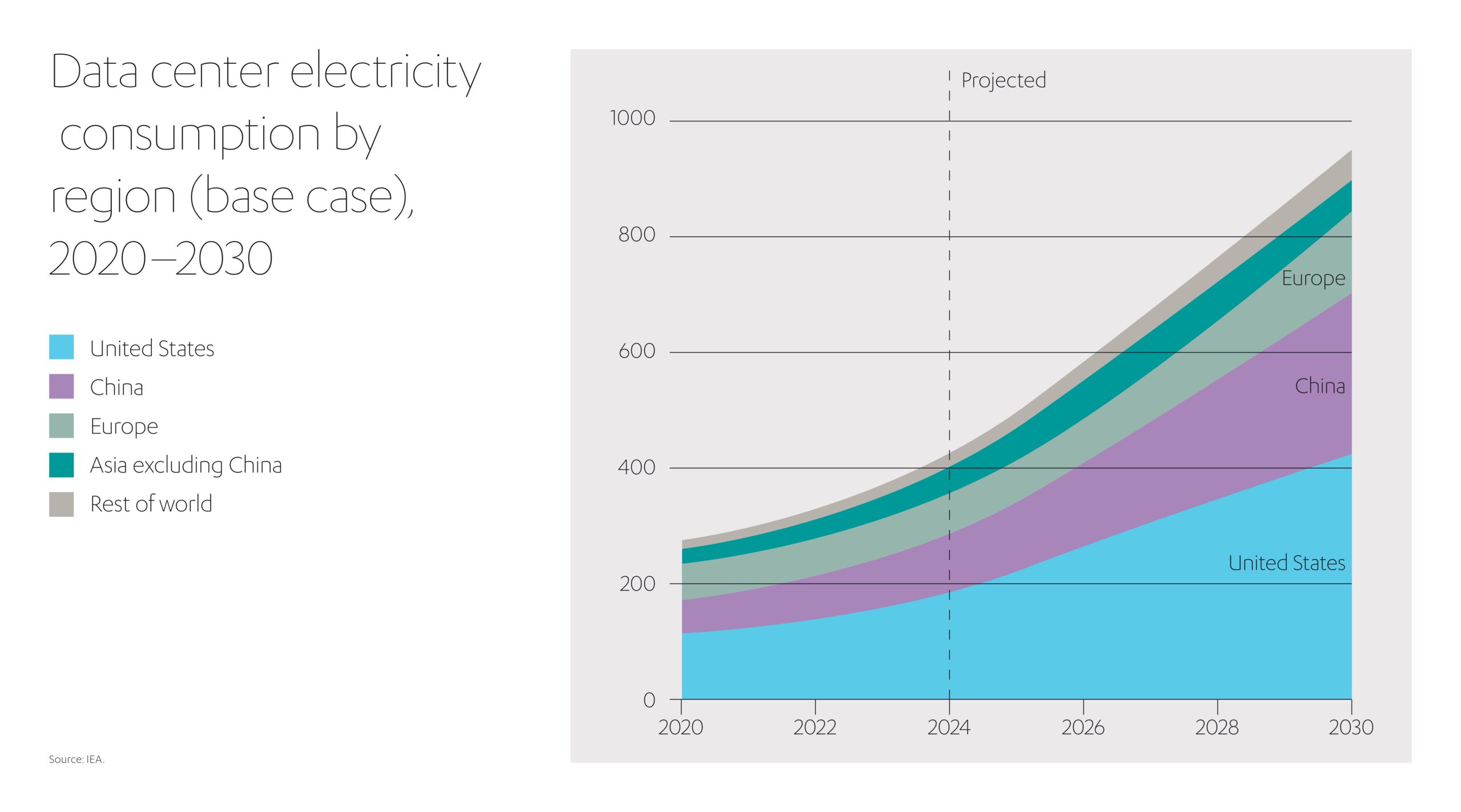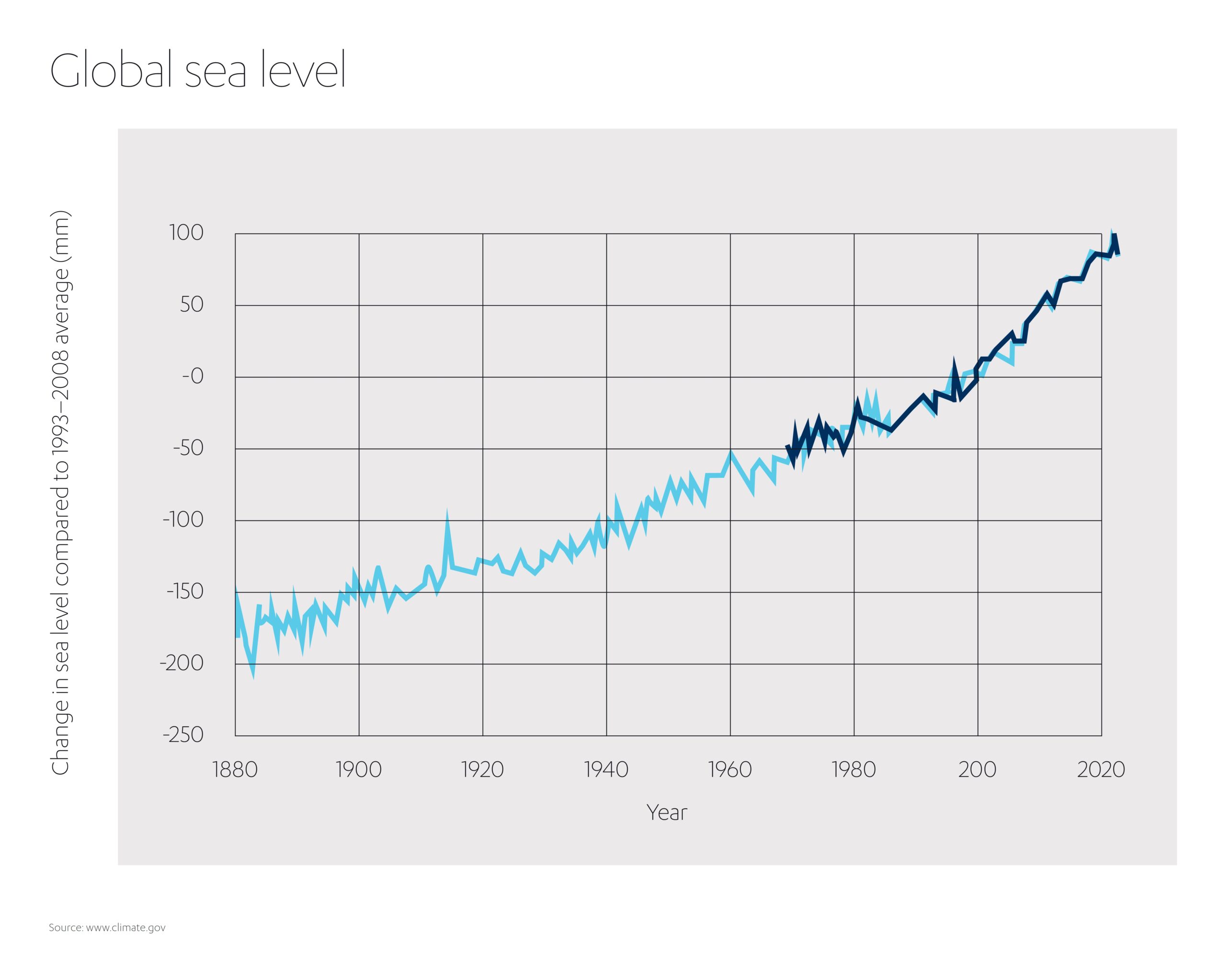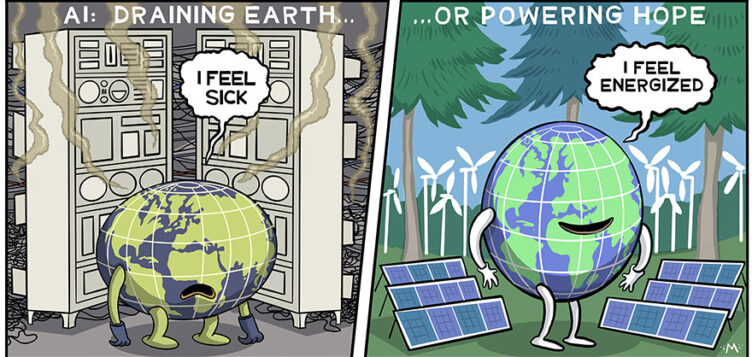Can AI help or hinder a greener future?
Artificial intelligence (AI) – we are told – is the secret weapon that could save us from a climate timebomb. It could potentially enable cleaner ways of living, reduce needless carbon emissions, and devise new ways of restoring our atmosphere to its natural balance.
There is just one problem . . . . AI itself has a significant carbon impact.
Developing and running AI models is emerging as one of the most energy-intensive activities in modern society. Today, one standard data center uses an amount of electricity equivalent to 100,000 homes.[1] If that sounds alarming, it is just the beginning. The largest data centers currently in development are likely to use 20 times that much power, equal to an astonishing two million homes. Soon, data centers will be sucking as much energy from the grid as, for example, a power-hungry aluminum smelter.
Anxiety about where all this electricity will come from is hardly impeding ambitions. Investment in data centers globally reached US$ 500,000,000,000 – half a trillion dollars – in 2024, doubling in the space of just two years.[2]
In 2024, data centers consumed 1.5% of the world’s energy output and emitted 1% of all greenhouse gases.[3] Yet data center energy usage is growing four times quicker than the rate of total electricity consumption, with no sign of slowing down. In fact, two-thirds of organizations globally plan to invest heavily in generative AI over the next 24 months.[4] With this trajectory, AI could be consuming up to 8% of the world’s total energy output by 2030.[5]
By that point, the International Energy Agency (IEA) predicts AI’s energy appetite will have risen to 945 TWh – rivalling the annual energy consumption of a mid-sized industrial nation.[6] In the USA, the epicenter of international AI development, data centers will by 2030 consume more electricity than is used for the production of chemicals, cement and steel combined.

Wall Street, as ever, is watching. AI is currently the rocket fuel driving US stock markets. Since 2022, when the first working AI models such as ChatGPT emerged, 65% of S&P 500 market capitalization growth (approximately US$ 12 trillion) has been achieved by companies openly fusing AI into their key functions.[7] Last year, AI-focused startups in the USA reached median valuations of US$ 5.5 billion – five times more than other generic startups.

Of course, this is not exclusively an American narrative. Beyond the USA, data centers in all mature economies are predicted to account for more than one-fifth of all growth in electricity demand this decade.[8]
Data centers compromise the environment not just directly – through electrical consumption, refrigerants, fuel cells and generators – but indirectly too, via the manufacture of high-end equipment, associated cloud services, and the reprocessing of end-of-life equipment. Together, all these outputs exacerbate climate change, air and water pollution, and resource depletion. So, why do we still consider AI as such a pivotal asset in the existential battle against global warming?

How can we reduce the environmental impact of AI?
Despite data centers representing such a significant drain on global power grids, scientists remain cautiously optimistic about the prospects of AI turning the tables on climate change.
Four billion people currently live in areas deemed climate-vulnerable, and an estimated 250,000 extra deaths are forecast per year from 2030 due to heat stress, malnutrition and disease.[9] As such, we need all the help we can get, even if our chief ally is digital rather than flesh and blood. The rapid evolution of AI heralds a whole range of game-changing climate interventions.
- Green energy: Renewable energy sources are providing an ever-greater proportion of the global energy mix. This trend will continue, with renewables contributing almost 20% of energy by 2030, up from 13% in 2023.[10] AI will prove vital for balancing decentralized power networks, seamlessly injecting solar, wind or hydro energy into grids to meet supply shortfalls. AI poses the prospect of generating energy with unprecedented efficiency: Existing infrastructure, it is believed, could provide 175 GW of additional transmission capacity simply by integrating remote sensors and AI-based management systems.[11]
- Weather prediction: As climate change intensifies, communities in vulnerable regions will need accurate weather forecasts to plan their lives. Some will need to know if a drought is coming so they can sow climate-prone seeds or stockpile crops; others may need emergency warnings to flee if hurricanes or floods are inbound. AI is so far proving adept at predicting weather patterns, with some cutting-edge tools delivering accurate forecasts ‘tens of times faster’ than conventional systems.[12] Sometimes, that is a life-or-death distinction.
- Emissions monitoring: AI-driven software can help businesses in the heavily polluting metal, mining, oil and gas markets to track and curtail their emissions. By analyzing data alongside live satellite imagery, emission-monitoring technology could help heavy industries – which together account for almost a third of greenhouse gases – cut their emissions by 20%-30%.[13]
- Ice-melt and deforestation: Global sea levels have risen more than 20 centimeters since 1880, reaching a new record high in 2023.[14] Floods at high tide are now at least 300% more likely to happen than 50 years ago. If we continue along our current emission trajectories, sea levels around US coastlines could reach two meters above pre-industrial levels by the end of this century.

Monitoring icebergs is vital both for warning the world about this danger and for strategizing solutions – and AI has been shown to calculate changes in ice cover 10,000 times faster than any human equivalent. Similarly, AI can also be used to measure the impacts of deforestation on the world’s climate. In 2022, a study by the Food and Agriculture Organization (FAO) blamed deforestation for around 11% of global greenhouse gas emissions that year.[15] AI can scrutinize millions of hectares of land in real-time using satellite data, equipped with precise knowledge about the amount of carbon stored within a particular forest.
- Recycling: Waste is responsible for around 16% of greenhouse gases.[16] Automatic sorting machines currently sift reusable materials – paper, tin, plastics – from our mixed refuse, with varied results. AI promises to govern this process with something approaching pinpoint accuracy, identifying plastic debris down to the nano-scale. If expanded globally, the technology could prevent millions of tons of reusable materials being erroneously sent to landfill annually.
Having established the importance of AI in the fight against climate change, attention turns to a possible solution. How can such an energy-intensive technology help shape a sustainable environment, without accidentally adding to the problem in the process?
Can better regulation encourage cleaner AI?
Around 90% of organizations globally say they are looking to spend heavily on AI in the coming years. While 75% of them acknowledge this will conflict with their sustainability policies, fewer than half have a strategy for offsetting this additional carbon footprint.[17]
State-level support can help organizations exploit the potential benefits of AI in a less environmentally harmful manner. Indeed, with AI being the cornerstone of many economic development plans, we are starting to see governments legislate for a greener ecosystem of data centers.
In Asia, the Korean New Deal of 2020 delicately balances digital and green priorities. Notably, it advocates a network of large-scale green data centers across the country, funded by public-private partnerships. An agreement between SK Broadband and local authorities in Gunsan, for instance, permits the construction of 16 new renewable energy-powered data centers by 2029, known as the Saemangeum Data Center Industrial Park[18].
The new German Energy Efficiency Act, meanwhile, aims to make the reuse of data center waste heat compulsory. Data centers in Germany must achieve minimums of 10% heat reuse by next year and 20% by 2028 – ambitious goals which could be used as a template by other countries if the industry can fulfil its obligations.
The European Union has made tentative steps towards lending data centers more green credibility by adopting an EU-wide scheme for rating their sustainability. Under the terms of the Energy Efficiency Directive, data center operators are obliged to report a series of climate-linked Key Performance Indicators to a European database by mid-May each year. The Directive aims to cut EU energy consumption by 11.7% by 2030 compared to forecasts from 2020.
Similarly, China’s Special Action Plan for Carbon Reduction aims to increase the use of renewable energy in the nation’s data centers by 10% by the end of this year, and in each subsequent year[19]. Looking ahead, electricity dependency, carbon emissions and waste heat reuse will be expected to reach even higher efficiency levels by 2030.
In America, the Environmental Protection Agency (EPA) has issued best practice guidance governing data centers to help reduce their carbon footprints. The Energy Star program covers airflow management, optimal operating temperatures, cabling quality and server efficiency[20]. At federal level, the government is considering compelling data center owners to report operating information and environmental performance metrics. It is hoped legislation will be passed within two years and will help with the greening of America’s buoyant cryptocurrency market.
With regulators demanding greater efficiency, how can the data center industry begin cutting its carbon footprint and engineering a greener destiny?
What ideas and innovations could help make data centers more sustainable?
As the emerging legislation suggests, multiple opportunities exist for making data centers – and hence AI as a concept – more eco-friendly.
- Servers in data centers are often prevented from superheating using chillers, and the compressors within these chillers are cooled by evaporating water. Since data centers use such a large amount of water they should only be considered in locations with plentiful and reliable supplies – not in places where water is scarce and needed more urgently for consumption or agriculture.
- Data center designers could consider alternatives to water such as ‘direct to chip’ cooling, whereby coolants are fed through ‘cold plates’ attached to heat-prone equipment. Alternatively, another technique is to submerge servers in a special dielectric (insulating) liquid that absorbs heat – known as immersion cooling. Both these methods are more costly than water at present, but prices should fall as the technology evolves and becomes more widespread.
- Data centers generate heat – lots of heat. Why waste it? Data centers typically emit heat waste at 30°C to 35°C; green heat pumps can elevate these temperatures further, up to 70°C to 80°C, ready for feeding into neighborhood grids to warm homes or supply hot water. Examples of efficient heat reuse are abundant. A trout farm in Norway, for example, and a series of leisure center pools throughout the UK, are already heated using pipe networks linked to nearby data centers.[21] Just 2% of UK heat originates from such heat networks at present, but the UK’s Climate Change Committee believes this figure could rise to 18% by mid-century if opportunities are maximized.[22]
- During grid blackouts data centers rely on generators for maintaining their cooling systems and staying operational. These fallback systems are often powered by fossil fuels – petrol, diesel, propane or gas. It need not be this way, with alternative fuel sources such as green hydrogen, ethanol, or hydrotreated vegetable oil increasingly available.
- Many data centers are already running on outdated equipment associated with heavier carbon footprints. Installing modern technology allows more of the data center’s potential to be deployed for its intended purpose of resolving complex sums – known as its power usage effectiveness (PUE) factor.
- Finally, considering that data centers consume large amounts of electricity, we must increase the share of renewable energies such as solar, wind and hydro power in the global energy market.
This last point is worth examining in more detail because it suggests not only a greener approach to AI, but exciting avenues for public sector involvement too.
How could the private sector boost green energy supply?
Data centers are thirsty for energy. Currently, the best estimates suggest they consume around 55 GW of energy annually, split between cloud computing, email storage and AI.[23] However, projections show demand increasing sharply to reach 84 GW as early as 2027, largely driven by the surge in AI. Data centers, like homes and offices, draw energy from the grid. So, one way to gauge the ‘greenness’ of data centers is to appraise the global energy supply.
Here, the news is mixed. Some 32.1% of the world’s energy was derived from renewable sources in 2024, largely shared between wind, solar and hydropower.[24] While this represents a quantum leap from the turn of the century (18.4% of global energy being renewable in 2000) it still means that more than two-thirds of energy around the world comes from fossil fuels. While confidence is high that the renewables sector can hit a 45.6% market share by 2030, capacity must grow considerably before AI can be exonerated from the global heating blame game.

Promisingly, the IEA believes renewables are in prime position to fill the global energy shortfall, citing economic competitiveness and short lead times for growing capacity. The green energy sector will grow by 450+ TWh by 2035 to meet burgeoning data center demand, according to its analysis. The IEA notes that the first wave of small modular nuclear reactors are due to come online by the end of the decade, primarily in Japan, the USA and China, further boosting the contribution of nuclear energy to the renewables market.[25]
With all this looming demand, global business consultancy McKinsey says commercial appetites will likely remain high for new renewable projects.[26] It foresees rising prominence for lesser-known alternative sources such as geothermal energy and biofuels, and a rapid growth in the number of Power Purchase Agreements (PPAs) underpinned by renewable electricity generation.
Abdul Latif Jameel is one of the key private sector players looking to harness the potential of AI while simultaneously ensuring it is powered by sustainable means.
Its flagship green energy business Fotowatio Renewable Ventures (FRV) operates a portfolio of solar and wind farms around the world, surpassing 5GW of energy across four continents. These schemes, and others like them, will prove vital in unlocking AI’s full potential without compromising our precious environment in the process. So too will the kind of utility-scale battery energy storage scheme (BESS) projects pioneered by FRV’s innovation arm, FRV-X. Operational sites in the UK include Holes Bay, Dorset; Contego, West Sussex; and Clay Tye, Essex. Two additional schemes are currently under construction in the Midlands. In Australia, FRV runs a BESS plant in Terang, Victoria, and a hybrid plant in Dalby, Queensland.
Similarly, Almar Water Solutions, part of Jameel Environmental Solutions, has invested in technology company Datakorum, focusing on the digital transformation of the water, energy and mobility sectors. Currently, Datakorum is busy in Abu Dhabi supplying 5G gateways for water and energy management systems – both critical components for a climate-stressed society.
The prospect of an AI-driven climate cure is tempting to entertain, perhaps because it absolves us of responsibility and delegates the job of finding a solution to an as-yet unproven technology. Addressing the data center energy quandary will require a two-pronged strategy. Firstly, by generating a greater share of the world’s energy from renewable resources so additional fossil fuel consumption is offset. Secondly, by exploring ways to cool data centers in a less water-intensive manner, while deploying the heat they emit for community use. Only with these tensions resolved will AI fulfil its promise of guiding us to a more sustainable and prosperous world.”
Five fast facts: Powering AI
Q: How much electricity does a standard data center consume?
A: One standard data center uses electricity equivalent to 100,000 homes, while the largest data centers in development will use 20 times that amount – equal to two million homes.
Q: What percentage of global energy could AI consume by 2030?
A: AI could be consuming up to 8% of the world’s total energy output by 2030, with the IEA predicting AI’s energy appetite will reach 945 TWh – rivaling a mid-sized industrial nation.
Q: How much did global investment in data centers reach in 2024?
A: Investment in data centers globally reached US$ 500 billion in 2024, doubling in just two years.
Q: What role does AI play in renewable energy management?
A: AI is vital for balancing decentralized power networks, seamlessly integrating solar, wind, or hydro energy into grids. Existing infrastructure could provide 175 GW of additional transmission capacity simply by integrating AI-based management systems.
Q: How much could AI help reduce emissions in heavy industries?
A: AI-driven emission-monitoring technology could help heavy industries – which account for almost a third of greenhouse gases – cut their emissions by 20%-30% by analyzing data alongside live satellite imagery.
[1] https://www.iea.org/reports/energy-and-ai/executive-summary
[2] https://www.iea.org/reports/energy-and-ai/executive-summary
[3] https://www.weforum.org/stories/2024/02/harnessing-waste-energy-data-centres//
[4] https://www.weforum.org/stories/2025/01/6-ways-data-centres-can-cut-emissions/
[5] https://www.weforum.org/videos/this-start-up-catches-waste-methane-to-power-data-centres/
[6] https://www.iea.org/news/ai-is-set-to-drive-surging-electricity-demand-from-data-centres-while-offering-the-potential-to-transform-how-the-energy-sector-works
[7] https://www.iea.org/reports/energy-and-ai/understanding-the-energy-ai-nexus
[8] https://www.iea.org/news/ai-is-set-to-drive-surging-electricity-demand-from-data-centres-while-offering-the-potential-to-transform-how-the-energy-sector-works
[9] https://www.weforum.org/stories/2024/02/ai-combat-climate-change/
[10] https://www.iea.org/reports/renewables-2024/global-overview
[11] https://www.iea.org/reports/energy-and-ai/executive-summary
[12] https://www.theguardian.com/technology/2025/mar/20/ai-aardvark-weather-prediction-forecasting-artificial-intelligence
[13] https://www.weforum.org/stories/2024/02/ai-combat-climate-change/
[14] https://www.climate.gov/news-features/understanding-climate/climate-change-global-sea-level
[15] https://fsc.org/en/blog/how-deforestation-affects-climate-change
[16] https://www.weforum.org/stories/2024/02/ai-combat-climate-change/
[17] https://www.weforum.org/stories/2025/01/6-ways-data-centres-can-cut-emissions/
[18] https://thedocs.worldbank.org/en/doc/08165a76ca0f1ef688d2782dfaab3406-0400072022/related/Greening-Digital-in-Korea-Korea-Case-Study-for-Greening-the-ICT-Sector.pdf
[19] https://english.www.gov.cn/news/202407/24/content_WS66a0b167c6d0868f4e8e96ba.html
[20] https://www.epa.gov/newsreleases/us-epas-energy-star-program-develops-energy-saving-guidance-co-location-data-centers
[21] https://www.weforum.org/stories/2024/02/harnessing-waste-energy-data-centres/
[22] https://datacentrereview.com/2024/06/making-the-most-of-data-centre-waste-heat/
[23] https://www.goldmansachs.com/insights/articles/ai-to-drive-165-increase-in-data-center-power-demand-by-2030
[24] https://www.iea.org/energy-system/renewables
[25] https://www.iea.org/reports/energy-and-ai/executive-summary
[26] https://www.mckinsey.com/industries/electric-power-and-natural-gas/our-insights/how-data-centers-and-the-energy-sector-can-sate-ais-hunger-for-power





 1x
1x


 Added to press kit
Added to press kit


